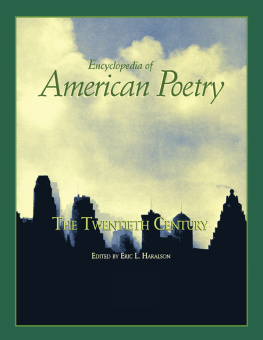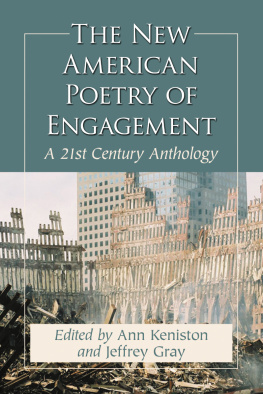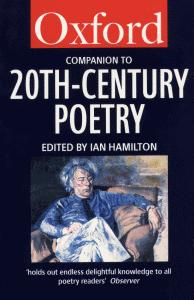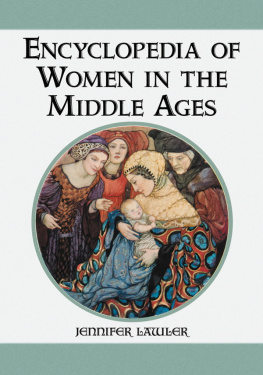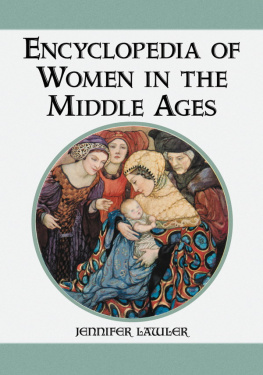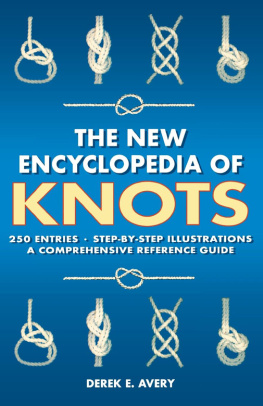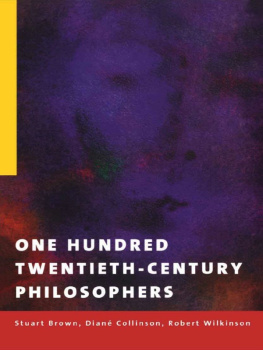Encyclopedia of
American Poetry
THE TWENTIETH CENTURY
Encyclopedia of
American Poetry
THE TWENTIETH CENTURY
EDITED BY ERIC L. HARALSON

Copyright 2001
FITZROY DEARBORN PUBLISHERS
All rights reserved including the right of reproduction in whole or in part in any form.
First published in the USA and UK 2001 by
Fitzroy Dearborn Publishers
This edition published 2012 by Routledge
Routledge
Taylor & Francis Group
711 Third Avenue
New York, NY 10017
Routledge
Taylor & Francis Group
2 Park Square, Milton Park
Abingdon, Oxon OX14 4RN
British Library and Library of Congress Cataloguing in Publication Data are available
ISBN 1-57958-240-0
Indexed by Jackie Orihill, Chicago, Illinois
Cover design by Peter Aristedes, Chicago Advertising and Design, Chicago, Illinois
In Memory of Jerome Notkin, with love for Janice


It has to be living, to learn the speech of the place.
It has to face the men of the time and to meet
The women of the time.
Wallace Stevens, Of Modern Poetry
To hear the poets tell it, poetry is what gets lost in translation. Poetry issues from the continual extinction of the authors personality. It makes nothing happen (although it is a way of happening), and in a certain mood, we are inclined to dismiss it as so much contemptible fiddle. Nothing that can be said about poetry is worth saying.
By these standards, this project takes on a tall order, for it aspires to find many things worth saying about American poetry of the last century, a period of literary history in which American poetry really came into its own (with all due regard for Dickinson, Whitman, and a handful of their peers). This book indeed seeks to translateor in other words, to explicate with care and tacta broad selection of poems; it also aims to recover the personality and life stories of the women and men who created such an abundant wealth of writing; and it further invites the reader to consider all that poetry has made happen both in the way of formal evolution and as a mode of intervention in the complex politics of the so-called American century.
In practical terms, these objectives are served by the following organization of contents:
Entries on individual poets feature a critical treatment of the poets achievements; a capsule biography; a list of her or his published books of poetry; and, as appropriate, a list of the poets selected criticism and other writings (such as memoirs, correspondence, or translations).
Entries on landmark poems offer close readings of the work thus distinguished and situate it within a historical and biographical context. These entries follow the relevant poet entries, so that five works by Robert Frost, from Desert Places to The Road Not Taken, are addressed immediately after the Frost entry, four works by Adrienne Rich, from An Atlas of the Difficult World to A Valediction Forbidding Mourning, are discussed after the Rich entry, and so forth.
Entries on major topics offer in-depth analysis of formal developments in 20th-century American poetry, under such headings as Free Verse, Long Poem, and Prosody and Versification; of distinct schools or movements, such as Beat Poetry, Black Mountain School, Objectivism, and Language Poetry; of poetry engaged in social and cultural politics, such as Gay and Lesbian Poetry, Religion and Poetry, and War and Anti-War Poetry; of the vibrant verse that has emerged from different ethnic traditions within our national literature, such as Asian American Poetry, Harlem Renaissance, Hispanic Poetry, and Native American Poetry; of verse of the Americas with which United States writing has conducted an intimate and intricate dialogue, such as Canadian Poetry and Caribbean Poetry; and of such crucial aspects of publication and reception as the marketing, teaching, and cultural valuation of poetry, such as Anthologies, Textbooks, and Canon Formation, Prizes, Little Magazines and Small Presses, and Literary Theory and Poetry.
All entriespoet, poem, or topicprovide a further reading list of key secondary sources on the subject of the given entry. Finally, certain poet entries are cross-referenced to topic entries where the poet in question comes in for additional treatment.
To borrow once again from the poets themselves, the goal of this volume is to demonstrate that this extraordinary body of poetry is important not because of any high-sounding interpretation, but because it has proven useful, in varied ways, to our culture. Throughout, we strive to honor American verse as a source of genuine meanings; as a process of finding, if not always satisfaction, then what will suffice; and as a force that can open chambers of possibility, restore feeling, and revitalize desire. At the end of the day, we are all interestedin the largest sense of the wordin poetry.
My wish, then, for those who consult this book is that reading it will do for you what editing it has done for me: greatly expand and enrich your appreciation of the power, beauty, and profundity of 20th-century American poetry. If this sounds like boasting, it is boasting on behalf of my team of almost 200 contributors, whose expertise and diligent labor will be apparent on every page. Beyond the contributions of these excellent scholars, the project has enjoyed the guidance of an advisory board made up of some of the most distinguished poets and critics (and poet-critics) working in American letters today. Without their insights, this volume would be a diminished thing, and although their names are listed elsewhere, I am pleased to repeat them here in a gesture of recognition for their generous and authoritative counsel: Christopher Beach, Charles Berger, Edward Halsey Foster, Dana Gioia, Elizabeth Gregory, John Hollander, Yusef Komunyakaa, Paul Mariani, Elisa New, Geoffrey OBrien, Marjorie Perloff, and Linda Wagner-Martin. Without prejudicing the case, I must add that my debt to John Hollander is now ancient, even if he remains young.
My sense of gratitude to Fitzroy Dearborn Publishers almost defies description. George Walsh rescued the precursor volumethe Encyclopedia of American Poetry: The Nineteenth Century from publishing oblivion, and his steadfast support is much appreciated. Paul Schellinger has been a model editorial director, firmly and sensitively steering the project through each phase of development. Other valued colleagues at Fitzroy Dearborn who were indispensable to making this big book go are Audrey Berns, Anne-Marie Bogdan, Jessica House, Thad King, Elizabeth Nishiura, and Heather Sabel. Gretchen Knapp and Bruce Owens copyedited every line and lineament of the monster, with keen intelligence and unfailing delicacy. Kudos, as well, to Peter Aristedes for selecting an eye-fetching piece of cover art, just as he did for the 19th-century poetry encyclopedia. But my greatest thanks and highest praise are reserved for my commissioning editor, Chris Hudson, who deserves more credit than anybody for making this reference work a reality. Chris is a volume editors dreamtirelessly dedicated, infinitely wise and helpful, and wonderfully witty when comic relief is called for (as happened once or twice). To my fellow authors in the field I say: you should be so lucky!
It is a pleasure to close with words of thanks and love to those who have been the real poetry in my lifeSusan, Sara, and Lucas, Kay and Howie, Janice and Jerry.
Next page
